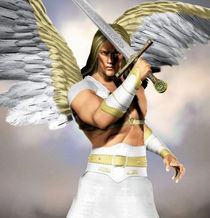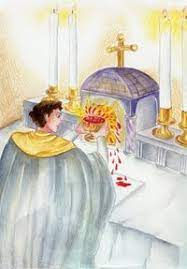The Guardian Angel: Eucharistic Miracle of Herdenrode -Hasselt, Belgium 1317
- Donald Hartley

- 4 hours ago
- 5 min read

Eucharistic Miracle of Herdenrode -Hasselt, Belgium 1317
In the Cathedral of St. Quintinus in Hasselt is exposed the relic of the Eucharistic miracle that took place in Herkenrode in 1317. During the course of the centuries, many tests were done to ascertain the miraculous preservation of the consecrated Host from which Blood flowed. We recall the test done in the 18th century by the Apostolic Nuncio Carafa and the Bishop of Liège or the one done by the Archbishop of Malines during a visit of the Archduchess Isabel. In the cathedral we also find numerous paintings depicting the miracle, done by a pupil of Jordaens, Jan van Boeckhorst.
On July 25, 1317, the pastor of the church in Viversel was called to the bedside of one his parishioners who was seriously ill, to receive the holy sacraments. Upon his arrival at the house of the sick person, he rested his handbag containing the consecrated Host on a table at the entrance and went to hear the confession of the sick person. One of the family members, curious about the handbag, opened it without being noticed. From it he pulled out the pyx, opened the cover and put his hand into it. As soon as he realized that inside there was a Host, he put everything back in order.

In the meantime, the priest came out from the room of the sick person to take out the Host with which to give him Communion. He took the handbag with the pyx inside, and when he opened it he saw that the Host he himself had consecrated during Mass was stained with Blood and was in some way stuck to the linen that covered the bottom of the container. Troubled and panic-stricken with the excuse that he had forgotten something, he rushed out of the house and went to the pastor of nearby Lumen to tell him what had happened. The latter advised him to bring the Particle to the Abbey of Herkenrode.
It was August 1, 1317. The priest left, taking the pyx with him. Along the road, extraordinary things happened. As soon as he arrived at the Benedictine monastery, he showed everybody the Host stained with Blood. Then, the face of Christ crowned with thorns appeared on the Host. This was attested to by numerous witnesses.
In the Cathedral of Hasselt there is a painting in which there is depicted a flock kneeling as the priest, carrying the sacred relic, passes by. In this place, called Sacramentsberg, a chapel was built as a perpetual memorial. From that time on, “the Blessed Sacrament of the Miracle,” which had been placed in a reliquary and exposed to public veneration, more than once protected the monastery of Herkenrode from fire. The reliquary of the miracle was kept at the Abbey until 1796, and in 1804, it was transferred to the Church of St. Quintinus in Hasselt.

The Didache or "The Teaching of the Twelve Apostles" is a manuscript which was used by 2nd century bishops and priests for the instruction of catechumens. Many early Christian writers have referenced it making this document relatively easy to date. "Let no one eat and drink of your Eucharist but those baptized in the name of the Lord; to this, too the saying of the Lord is applicable: 'Do not give to dogs what is sacred'". E-Ch. 9:5 "On the Lord's own day, assemble in common to break bread and offer thanks; but first confess your sins, so that your sacrifice may be pure. However, no one quarreling with his brother may join your meeting until they are reconciled; your sacrifice must not be defiled. For here we have the saying of the Lord: 'In every place and time offer me a pure sacrifice; for I am a mighty King, says the Lord; and my name spreads terror among the nations.'" -Ch 14
ST. CLEMENT OF ROME (Alt) St. Clement was the third successor of Peter as Bishop of Rome; otherwise known as the third Pope. "Since then these things are manifest to us, and we have looked into the depths of the divine knowledge, we ought to do in order all things which the Master commanded us to perform at appointed times. He commanded us to celebrate sacrifices and services, and that it should not be thoughtlessly or disorderly, but at fixed times and hours. He has Himself fixed by His supreme will the places and persons whom He desires for these celebrations, in order that all things may be done piously according to His good pleasure, and be acceptable to His will. So then those who offer their oblations at the appointed seasons are acceptable and blessed, but they follow the laws of the Master and do not sin. For to the high priest his proper ministrations are allotted, and to the priests the proper place has been appointed, and on Levites their proper services have been imposed. The layman is bound by the ordinances for the laity." Source: St. Clement, bishop of Rome, 80 A.D., to the Corinthians "Our sin will not be small if we eject from the episcopate those who blamelessly and holily have offered its Sacrifices." Source: Letter to the Corinthians, [44,4]

ST. IGNATIUS OF ANTIOCH (Alt)St. Ignatius became the third bishop of Antioch, succeeding St. Evodius, who was the immediate successor of St. Peter. He heard St. John preach when he was a boy and knew St. Polycarp, Bishop of Smyrna. Seven of his letters written to various Christian communities have been preserved. Eventually, he received the martyr's crown as he was thrown to wild beasts in the arena. "Consider how contrary to the mind of God are the heterodox in regard to the grace of God which has come to us. They have no regard for charity, none for the widow, the orphan, the oppressed, none for the man in prison, the hungry or the thirsty. They abstain from the Eucharist and from prayer, because they do not admit that the Eucharist is the flesh of our Savior Jesus Christ, the flesh which suffered for our sins and which the Father, in His graciousness, raised from the dead." "Letter to the Smyrnaeans", paragraph 6. circa 80-110 A.D.
"Come together in common, one and all without exception in charity, in one faith and in one Jesus Christ, who is of the race of David according to the flesh, the son of man, and the Son of God, so that with undivided mind you may obey the bishop and the priests, and break one Bread which is the medicine of immortality and the antidote against death, enabling us to live forever in Jesus Christ." -"Letter to the Ephesians", paragraph 20, c. 80-110 A.D.
"I have no taste for the food that perishes nor for the pleasures of this life. I want the Bread of God which is the Flesh of Christ, who was the seed of David; and for drink I desire His Blood which is love that cannot be destroyed." -"Letter to the Romans", paragraph 7, circa 80-110 A.D.
"Take care, then who belong to God and to Jesus Christ - they are with the bishop. And those who repent and come to the unity of the Church - they too shall be of God, and will be living according to Jesus Christ. Do not err, my brethren: if anyone follow a schismatic, he will not inherit the Kingdom of God. If any man walk about with strange doctrine, he cannot lie down with the passion. Take care, then, to use one Eucharist, so that whatever you do, you do according to God: for there is one Flesh of our Lord Jesus Christ, and one cup in the union of His Blood; one altar, as there is one bishop with the presbytery and my fellow servants, the deacons." -Epistle to the Philadelphians, 3:2-4:1, 110 A.D.





















Comments